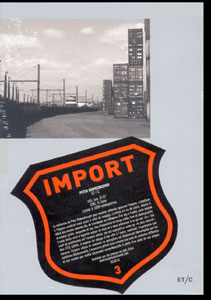An urban journey.
Peter Downsbrough's aim to present, reflect on and experience space deals with constructed landscapes as well as with language. Since his beginnings in the early 60s, this American artist has continuously transposed his reflections from one medium to another: post cards, public spaces, models with sound, exhibitions, video images books and photographs, each time inviting us to look around and take interest in what is there. ET/C, proposing a journey from one city to another, points out the significance of the urban landscape and how the perception of it is multiplied though numerous visits. Space is thus defined as a string of varied contexts rather than as a totally comprehensible reality from a single point of view.
ET/C is the second DVD by Peter Downsbrough in the
Import series, following
From [to]. He also realized a 3 DVD box published by Le Fresnoy art center:
Group-ED.
Also available, the monograph
Peter Downsbrough – ET/C.
The work of visual artist, photographer and film artist Peter Downsbrough (1940-2024)
has had a major impact on the perception of art. The varied work of the artist—ranging from sculpture and books to photography,
video, and film—maintained a complex relationship with architecture and
typography, while also drawing on the achievements of the early avant-garde
(Bauhaus, De Stijl) and Minimal Art.
In terms of form, the work of Downsbrough
is highly rigorous and exhibits a powerful geometric sense, restricting itself
primarily to the use of line, plane, negative space (cutting away), and
delimitation. In addition to his spatial manipulations, the artist also has
a keen interest in place, as is evidenced in his cartographical works and
city photographs.
Downsbrough studied architecture and art. Around the mid-1960s, after several years of work and exploring materials, an evolution took place with resulted, in 1970, in the work with the Two Pipes (outside), Two Dowels (inside), and Two Lines (on paper). At the same time, he also started taking photographs to document these pieces. Buy taking photographs of "cuts" that already existed in the urban landscape. Some of these photographs were used in books, some appeared in magazines, but it wasn't until 1960 that they showed up in exhibitions. From 1977 on, Downsbrough realized several videos as well as audiotapes. A record was made in 1978 and released in 1982. In 1980, on the Spectacolor Board on Times Square, N.Y., he realized a piece, a 30 second spot shown once every hour for four days and documented it in a short film, "7 come 11". The work with maquettes as a means of exploring space and structure started around 1983. The first commissioned public work was a wall piece realized in Rennes, France, 1990.


